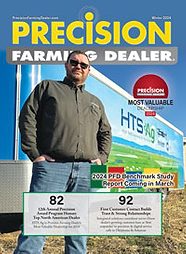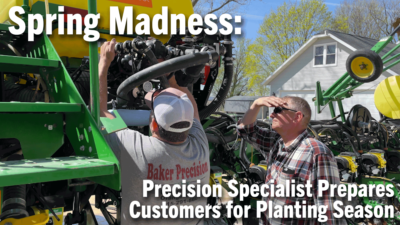The rapidly evolving field of ag tech is being driven by a confluence of factors including projections of an increasing world population, limited land resources, automation and sensor densification of agricultural field machinery, connection of this equipment to the internet, remote sensing via unmanned aerial systems and cloud computing.
Mix in the availability of venture capital and keeping up with ag tech developments is challenging even for the most tech-savvy individuals. U.S. farmers now generate agricultural production data at rates measured in petabytes per growing season.
What is a petabyte you ask? Roughly, it is equivalent to the data storage capacity of 1.5 million CDs. As one might guess, most agricultural producers are overwhelmed with how to parse this data and extract actionable information.
Increasingly, many ag tech companies are now turning to artificial intelligence, or AI, to capitalize on collected data. While AI is not new, access to this technology is now possible via cloud computing. Perhaps one of the more common and widely deployed AI applications is voice or speech recognition.
Have you heard of Amazon’s Echo or Google’s Home? These devices are rapidly changing the way we use and access the internet. Once driven by a PC web browser, much of our internet interaction will be voice driven through these devices in the future.
Hence, AI, or a computer’s ability to analyze human speech, is changing how humans interact with technology. With this brief explanation, let’s consider how AI might change the way farmers access and use ag tech.
“Will AI replace crop advisors or other agriculture professionals? Unlikely…”
As producers turn their attention to 2018 cropping plans, what technology will drive the development of these plans — grid or targeted soil sampling, specification of seeding rates, upgrading sprayer application technology, purchasing remote sensing service? More importantly, should these be “seat of the pants” decisions or, will your customers be better served through data-driven decision-making?
Let’s examine how AI might supplement decision-making process beyond the 2018 cropping season. When it comes to soil sampling, how often should grid soil sampling be repeated, and is this cost justified?
The use of AI may help farmers to be more strategic when pulling and analyzing soil cores, and then to extrapolate these results to other locations within a field or other fields thereby reducing overall sample collection and analyses costs. Further, fertility prescriptions might be adjusted annually in recognition of a new crop mix or rotation coupled with grain futures to optimize economic returns to the farming enterprise.
AI will enable us to mine existing data sets (historical yield, fertility and elevation maps) to extract patterns that will inform the decision-making process. Perhaps the greatest challenge in production agriculture is management in response to weather, and most specifically nitrogen (N) management in corn.
Many factors influence supplemental N needs of the crop including precipitation and N mineralization by the soil, the latter governed to some extent by soil moisture and temperature. While predicting the weather may be the holy grail, in-season N application might be AI driven in the future.
Current N management approaches are model driven — most likely statistical in nature based on previous N application studies. However, as we continue to collect production data over a range of weather conditions and N application practices, new AI driven approaches will better inform within season N management recommendations.
Unmanned Aerial Systems provide a new option for managing crop health. Unfortunately, simply delivering timely remote sensing images to farmers provides little in the way of new management information.
Once again, AI may prove to be a valuable tool when tracking crop performance during the growing season, and then helping to direct human scouts to under-performing locations within a field. AI approaches will enable crop advisors to comb through significant volumes of imagery to identify fields or, areas of fields, in need of corrective treatment to mitigate crop-loss stemming from nutrient, insect or disease pressure.
Will AI replace crop advisors or other agriculture professionals? Unlikely. However, AI will assist crop advisors and farmers to extract actionable information from volumes of data collected from soil and tissue samples, on-board machinery sensors, weather stations and remote sensing platforms.
Concerned about what to do with all that production data you’ve been collecting? Rest assured that help is on the way via could-based AI






Post a comment
Report Abusive Comment